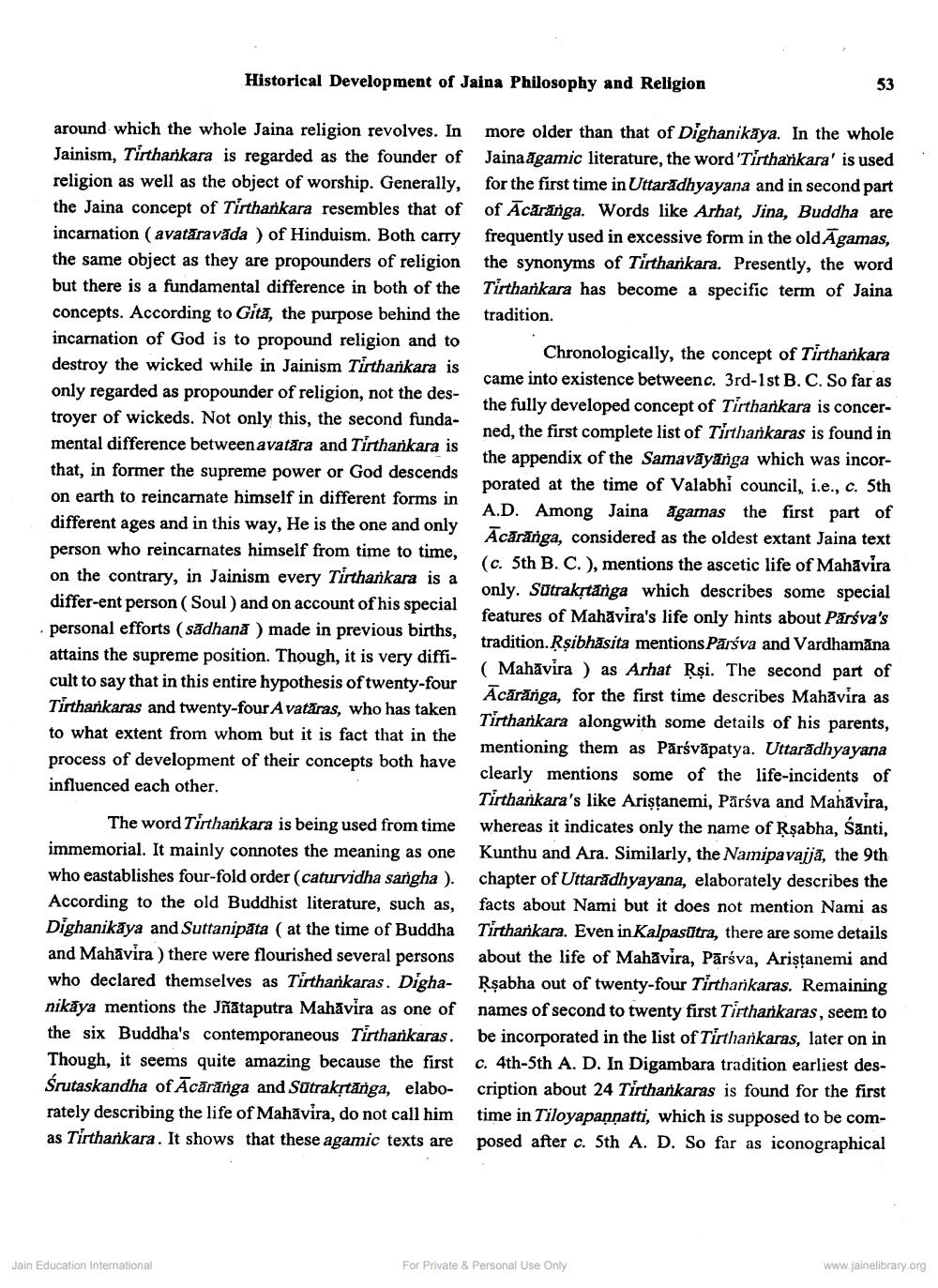________________
Historical Development of Jaina Philosophy and Religion
53
around which the whole Jaina religion revolves. In more older than that of Dighanikaya. In the whole Jainism, Tirthankara is regarded as the founder of Jainaāgamic literature, the word 'Tirtharikara' is used religion as well as the object of worship. Generally, for the first time in Uttaradhyayana and in second part the Jaina concept of Tirtharkara resembles that of of Ācāranga. Words like Arhat, Jina, Buddha are incarnation ( avatāravāda ) of Hinduism. Both carry frequently used in excessive form in the old Āgamas, the same object as they are propounders of religion the synonyms of Tirthankara. Presently, the word but there is a fundamental difference in both of the Tirtharikara has become a specific term of Jaina concepts. According to Gita, the purpose behind the tradition. incarnation of God is to propound religion and to
Chronologically, the concept of Tirthankara destroy the wicked while in Jainism Tirthankara is
came into existence betweenc. 3rd-1st B.C. So far as only regarded as propounder of religion, not the des
the fully developed concept of Tirthankara is concertroyer of wickeds. Not only this, the second funda
ned, the first complete list of Tirthakaras is found in mental difference between avatāra and Tirthankara is
the appendix of the Samavāyārga which was incorthat, in former the supreme power or God descends
porated at the time of Valabhi council, i.e., c. 5th on earth to reincarnate himself in different forms in
A.D. Among Jaina agamas the first part of different ages and in this way, He is the one and only
Ācāranga, considered as the oldest extant Jaina text person who reincarnates himself from time to time,
(c. 5th B. C.), mentions the ascetic life of Mahavira on the contrary, in Jainism every Tirtharkara is a
only. Sutrakļānga which describes some special different person (Soul) and on account of his special
features of Mahāvira's life only hints about Parśva's personal efforts (sādhana ) made in previous births,
tradition. Rşibhasita mentions Pārsva and Vardhamana attains the supreme position. Though, it is very diffi
( Mahavira ) as Arhat Rşi. The second part of cult to say that in this entire hypothesis of twenty-four
Ācārānga, for the first time describes Mahāvira as Tirtharkaras and twenty-four Avatāras, who has taken
Tirtharkara alongwith some details of his parents, to what extent from whom but it is fact that in the
mentioning them as Pārśvāpatya. Uttaradhyayana process of development of their concepts both have
clearly mentions some of the life-incidents of influenced each other.
Tirtharikara's like Aristanemi, Pārśva and Mahāvira, The word Tirtharikara is being used from time whereas it indicates only the name of Rşabha, śānti, immemorial. It mainly connotes the meaning as one Kunthu and Ara. Similarly, the Namipavaijā, the 9th who eastablishes four-fold order (caturvidha sangha ). chapter of Uttaradhyayana, elaborately describes the According to the old Buddhist literature, such as, facts about Nami but it does not mention Nami as Dighanikāya and Suttanipāta ( at the time of Buddha Tirtharkara. Even in Kalpasūtra, there are some details and Mahāvira ) there were flourished several persons about the life of Mahāvira, Pārsva, Aristanemi and who declared themselves as Tirtharikaras. Digha- Rşabha out of twenty-four Tirtharikaras. Remaining nikāya mentions the Jñataputra Mahāvira as one of names of second to twenty first Tirthankaras, seem to the six Buddha's contemporaneous Tirthankaras. be incorporated in the list of Tirtharkaras, later on in Though, it seems quite amazing because the first c. 4th-5th A. D. In Digambara tradition earliest desŚrutaskandha of Ācārănga and Satrakņtānga, elabo- cription about 24 Tirthankaras is found for the first rately describing the life of Mahāvira, do not call him time in Tiloyapannatti, which is supposed to be comas Tirthankara. It shows that these agamic texts are posed after c. 5th A. D. So far as iconographical
Jain Education International
For Private & Personal Use Only
www.jainelibrary.org




